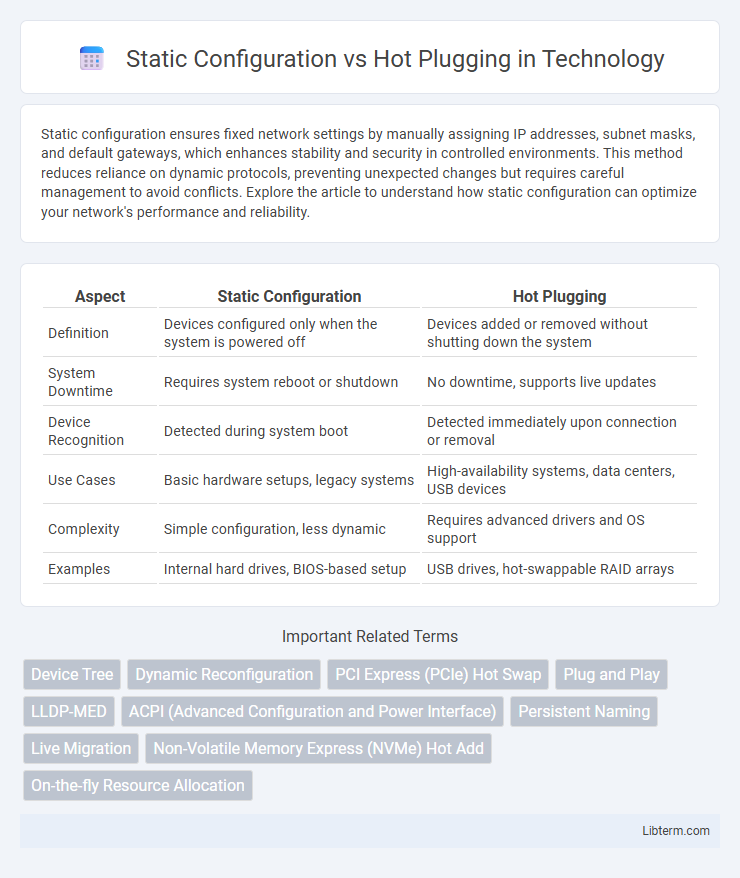Static configuration ensures fixed network settings by manually assigning IP addresses, subnet masks, and default gateways, which enhances stability and security in controlled environments. This method reduces reliance on dynamic protocols, preventing unexpected changes but requires careful management to avoid conflicts. Explore the article to understand how static configuration can optimize your network's performance and reliability.
Table of Comparison
| Aspect | Static Configuration | Hot Plugging |
|---|---|---|
| Definition | Devices configured only when the system is powered off | Devices added or removed without shutting down the system |
| System Downtime | Requires system reboot or shutdown | No downtime, supports live updates |
| Device Recognition | Detected during system boot | Detected immediately upon connection or removal |
| Use Cases | Basic hardware setups, legacy systems | High-availability systems, data centers, USB devices |
| Complexity | Simple configuration, less dynamic | Requires advanced drivers and OS support |
| Examples | Internal hard drives, BIOS-based setup | USB drives, hot-swappable RAID arrays |
Introduction to Static Configuration and Hot Plugging
Static configuration involves setting hardware or system parameters prior to operation, requiring a complete shutdown to modify or upgrade components. Hot plugging allows devices to be added, removed, or replaced without powering down the system, enhancing flexibility and uptime in dynamic environments. Understanding the distinction between these methods is crucial for optimizing system management and minimizing downtime in computing infrastructure.
Defining Static Configuration
Static configuration refers to the manual setup of hardware components and system parameters before operation, ensuring fixed resource allocation without changes during runtime. This method requires predefined settings, such as IP addresses, device memory, and interrupt requests, which remain constant until manually modified. Static configuration enhances system stability and predictability but lacks flexibility compared to hot plugging, where components can be added or removed without shutting down the system.
Understanding Hot Plugging
Hot plugging enables the addition or removal of hardware components, such as USB devices or PCIe cards, without shutting down the system, enhancing operational flexibility and uptime. This feature relies on dynamic hardware detection protocols and driver support to ensure seamless integration and functionality during runtime. Understanding hot plugging requires familiarity with device enumeration, power management, and interrupt handling to prevent data loss and hardware conflicts.
Key Differences Between Static Configuration and Hot Plugging
Static configuration requires devices to be installed and configured before system startup, ensuring stable hardware recognition without runtime changes. Hot plugging enables devices to be connected or disconnected while the system is running, allowing dynamic hardware management without rebooting. The key differences lie in operational flexibility, with static configuration offering fixed setup and hot plugging providing seamless hardware integration during live operation.
Pros and Cons of Static Configuration
Static configuration ensures system stability and predictable performance by defining hardware or software settings during initial setup, reducing the risk of runtime errors or conflicts. It can limit flexibility and scalability since changes require system downtime or manual reconfiguration, hindering quick adaptation to new requirements. However, static configuration excels in environments where consistency, security, and reliability are paramount, such as embedded systems or critical infrastructure.
Advantages and Limitations of Hot Plugging
Hot plugging enables the addition or removal of hardware components, such as USB devices or storage drives, without shutting down the system, enhancing operational flexibility and reducing downtime. This capability supports dynamic resource management and maintenance in live environments but may introduce risks of system instability or data corruption if devices are improperly handled. Limitations include dependence on hardware and software compatibility, potential power surges, and the need for robust driver support to ensure seamless integration during hot plug events.
Use Cases for Static Configuration
Static configuration is ideal for environments with fixed hardware setups, such as industrial control systems and embedded devices, where consistent performance and stability are critical. It ensures reliable operation by predefining hardware parameters, minimizing runtime errors and system interruptions. This approach suits applications requiring predictable behavior and stringent real-time processing.
Real-World Applications of Hot Plugging
Hot plugging enables the dynamic addition or removal of hardware components like USB devices, network cards, and storage drives without shutting down the system, enhancing uptime and flexibility in data centers and consumer electronics. This capability supports critical real-world applications such as server maintenance, live system upgrades, and rapid hardware fault recovery, minimizing operational disruptions. Compared to static configuration, where hardware changes require system downtime, hot plugging facilitates seamless scalability and efficient resource management in both enterprise and personal computing environments.
Choosing Between Static Configuration and Hot Plugging
Choosing between static configuration and hot plugging depends on system flexibility and downtime tolerance. Static configuration offers stability and predictable performance by requiring system shutdowns for hardware changes, ideal for environments prioritizing reliability over convenience. Hot plugging enables dynamic hardware addition or replacement without interrupting operations, suited for systems demanding high availability and minimal downtime.
Future Trends in Device Management: Static vs. Dynamic Approaches
Future trends in device management emphasize a shift from static configuration, which requires manual setup and restart, to dynamic hot plugging that enables seamless device integration and removal without system downtime. Advances in AI-driven orchestration and edge computing are accelerating the adoption of hot plugging, improving scalability and responsiveness in IoT and data center environments. Enhanced firmware and protocol standards like USB4 and PCIe 5.0 support dynamic device management, facilitating faster, more reliable hot plugging capabilities for evolving hardware ecosystems.
Static Configuration Infographic

 libterm.com
libterm.com